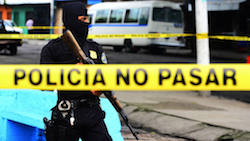The homicide rate in El Salvador showed improvement in the first half of September, continuing a steady decline in violent deaths seen over the past six months, though the country still has a long way to go to achieve murder rates in line with international norms.
The National Civil Police (Policia Nacional Civil – PNC) recorded 4,000 homicides from the beginning of the year through mid-September, 13.3 percent fewer than the same period in 2015, when 4,614 cases were registered, La Prensa Gráfica reported.
The newspaper reported an average of 10.9 homicides per day for the first 15 days of September as compared to an average of 15.4 per day so far in 2016. The 2016 daily average is lower than in 2015, a year that represented a spike in violent deaths as compared with 2014, with an average of 10.7 homicides a day, and 2013, when the rate was 6.9 per day.
The year 2016 started with a bang, with the 740 homicides in January reflecting a continuation of El Salvador’s 2015 status as the most violent nation in the Western Hemisphere. The country had an overall homicide rate of 104.2 per 100,000 inhabitants in 2015. However, since April there has been a steady decrease in homicides.
The recent figures from the PNC also highlight a shift in the location of the homicides. Of the 4,000 killings registered so far in 2016, 59.1 percent occurred in rural areas.
InSight Crime Analysis
Any reduction in homicides is welcome in one of Latin America’s most violent societies, and that there have been fewer murders is beyond dispute. How that improvement was achieved, however, is still a question of debate.
The government maintains that the lower homicide rate is a reflection of its hardline policies to combat the El Salvador’s violent street gangs, and especially the Mara Salvatrucha (MS13) and Barrio 18.
The government instituted emergency measures in prisons aimed at isolating gang leaders being held in the facilities. El Salvador also dispatched joint units of the police and military to pursue gang cells, or cliques, in the Salvadoran countryside. President Salvador Sánchez Cerén has stated that these “extraordinary measures have helped in the last few months in the reduction of the number of homicides.”
On the other hand, as El Faro reported, these same gangs have taken the credit for the reduction, claiming that it was due to the leaders ordering a stop to assassinations, which came at the end of March just before the homicide rate registered a dramatic decrease, from a daily average of 19.7 in March to one of 11.8 in April.
SEE ALSO: El Salvador News and Profiles
The apparent shift toward the countryside may support the gangs’ claim that a lull in fighting between the MS13 and Barrio 18 is responsible for improved homicide rates. The two gangs have traditionally been mortal enemies and their turf wars over the country’s most populous, low income, urban neighborhoods have been the main motor for murders in El Salvador.
There have also been signs of an increase in gang members being killed by the security forces, often in reported confrontations that end with very one-sided death tolls. Whether the apparent decrease in gang-on-gang murders is a product of a de facto truce between the gangs or of increased pressure from the police and military is unclear.
However, even with the reported reduction in homicides El Salvador remains one of the most violent countries in the world. The small Central American country still is a long way to go to achieve murder rates that approach international norms.

